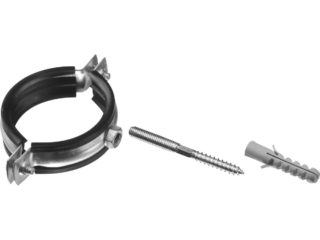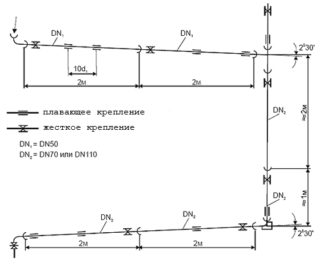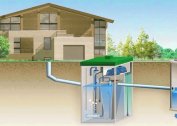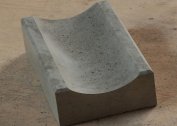When installing sewage highways, for the correct fixation of pipe segments, special fasteners are used - clamps. They are made of metal and plastic. Structurally, clamps made of different materials are similar, their geometrical sizes and devices for holding screws differ.
Clamp design and mounting advantages
The clamp design consists of several basic elements:
- half rings;
- special sealing gaskets;
- pin fixing element;
- screw stud.
The structure is attached to the wall with screws, anchors or dowels. If the product is selected to already purchased pipes, it is important to choose the right section of the fastener. For example, a clamp for fastening frequently used sewer pipes with an outer diameter of 110 mm should have a similar size inside.
It is easier if the fastening comes complete with pipe pieces, fitting parts, other sewage fittings.
The main advantage of using pipe clamps is the reliability of the structure. Rubber gaskets inside them reduce noise and wastewater vibrations. Among the shortcomings of such elements, only one can be distinguished - they do not have a presentable appearance.
Types of fixtures for sewage
When carrying out plumbing works, the following types of fasteners are used to fix sewage networks:
- Crimp. They can be fixed and crimped at the junction of the pipe segments and fitting elements to increase the tightness of the docked nodes.
- Guides. Applied when positioning the sewer pipeline relative to the bearing base. These are more markers than fasteners.
- Supporting. Needed to secure the trunk to the wall. Such fixing parts are equipped with rubber gaskets to compensate for vibration and linear deformation.
- Safety Install in difficult areas that require additional fixation.
Fire clamps are also produced. They are used if the riser and the pipeline itself are made of polymer materials. In case of fire, such a clutch will prevent the spread of fire and smoke along the line or through an opening in the stove.
The locking elements are made of steel and plastic. Both types are quite simple and convenient during installation.
When choosing which clamps to purchase - from plastic or metal - pay attention to the aesthetics of the room where the sewer pipe will be located. This is important if it is conducted in an open way and is not hidden inside interior structures or walls. PVC fasteners are more attractive and subtle.
Steel products with a rubber seal have greater rigidity, therefore, they are used to fasten heavy lines. The gasket installed in them provides a soft tight fit and protects the pipeline from premature wear at the attachment points.
Polymer products are not suitable if:
- heavy cast iron pipes are placed;
- additional equipment is installed on the highway;
- sewer pipeline is operated in vibration conditions.
The clamp for mounting cast-iron sewer pipes should only be metal. Depending on the cross section of the highway, different types of fasteners are selected. After all, the larger the diameter, the heavier the pipe. Heavy-duty products are suitable for segments with a cross section of 50 mm, and heavy-duty clamps are chosen for 110 mm.The fasteners are made of a steel strip with zinc plating.
The structural characteristics of the clamp holders are standard and must meet all the parameters specified in GOST. Each manufacturer must indicate the typical dimensions not only in the quality certificate, but also on the surface of the fastener.
Work execution technology
In plumbing works, two types of clamp attachment of highways are used: hard and floating. In the first case, the pipes are fixed with crimp parts that are brought under the socket or put on the body of the fitting element. Their main task is to securely fix the junction of pipe segments or pipes and fittings.
The second option is performed using guides or supporting fasteners, which ensure the integrity of the pipeline during its thermal deformations. It is needed if the communications are made of polymers, since they are modified under the influence of temperature changes. The inner diameter of the fixing part must be larger than the outer section of the pipe section, which allows the pipeline to move in the longitudinal direction.
For both options, the same types of mounts are used. But there are also fasteners that are used exclusively for floating fixation. This type of clamp is not equipped with clamping, tightening bolts. They are convenient because they snap into place and do not require the use of special equipment during their installation.
Installation of standard clamps is simple. A hole is drilled in the wall, a clamp is fixed on the dowel, after that the pipe is installed in the retainer and the crimp screws are tightened. When using plastic elements, they simply snap into place.
If it is necessary to leave a large distance between the sewage pipeline and the basement, the installation of fasteners is performed differently. Anchor dowels with internal thread are fixed in the ceiling, a threaded rod of the required length is screwed in, and a clamp is installed on it.
Attachment Rules
In order for the wiring of the sewage system to be done qualitatively, it is necessary to follow certain rules. Strict adherence to the standards allows you to protect the sewer pipeline from factors leading to deformation: high pressure, vibration, the appearance of rust and blockages.
When fixing sewer pipes with clamps, one should consider:
- The distance between the pipe and the wall should be kept to a minimum. If necessary, increase the distance using special locking elements made of metal.
- The step with which the clamps will be mounted depends on the cross-section of the pipe. At 50 mm, the distance will be 400 mm, at 100 mm - 800 mm.
- Fasteners are installed only on flat areas, the distance to the turn is at least 150 mm. Be sure to fix the junction of pipes and fittings. To reliably determine the location of the fixtures, you will need to draw a general outline of the highway in advance and transfer it directly to the walls with axial lines.
- Clamp holders are installed with a minimum pipe slope of 2 cm per meter.
Each pipe must be fixed with at least one non-slip fixing fixture, usually located at the socket - the place of its docking with other parts of the pipeline.
The sewer system in the process is subjected to loads, vibrations, temperature jumps. This means that pipe lines require reliable fixation to the walls or other supporting surfaces. Dowels or anchors for mounting fasteners must be firmly held in the supporting material without painting or cracking.






